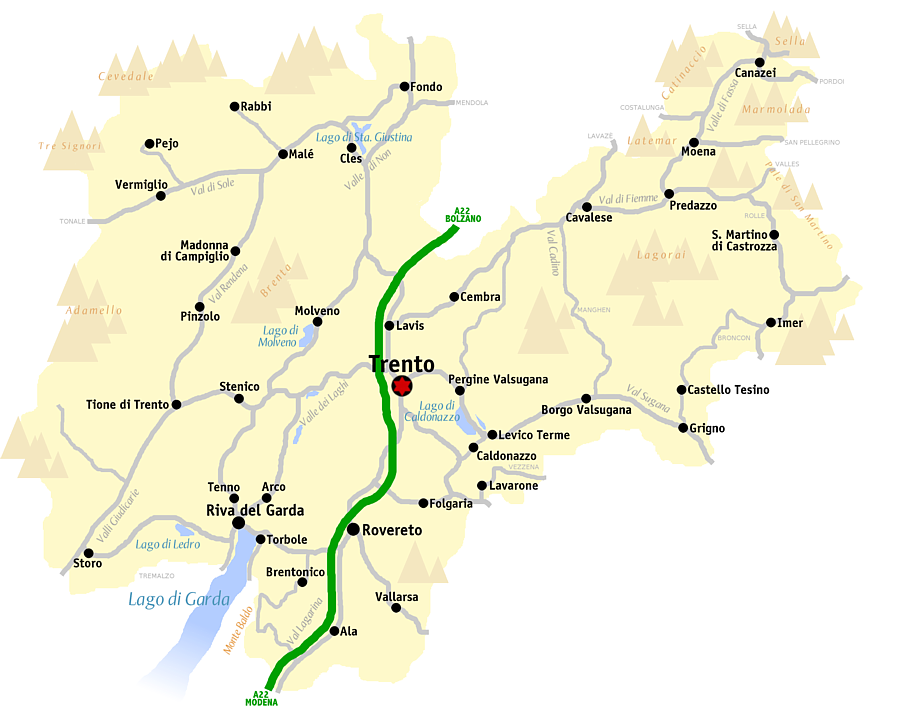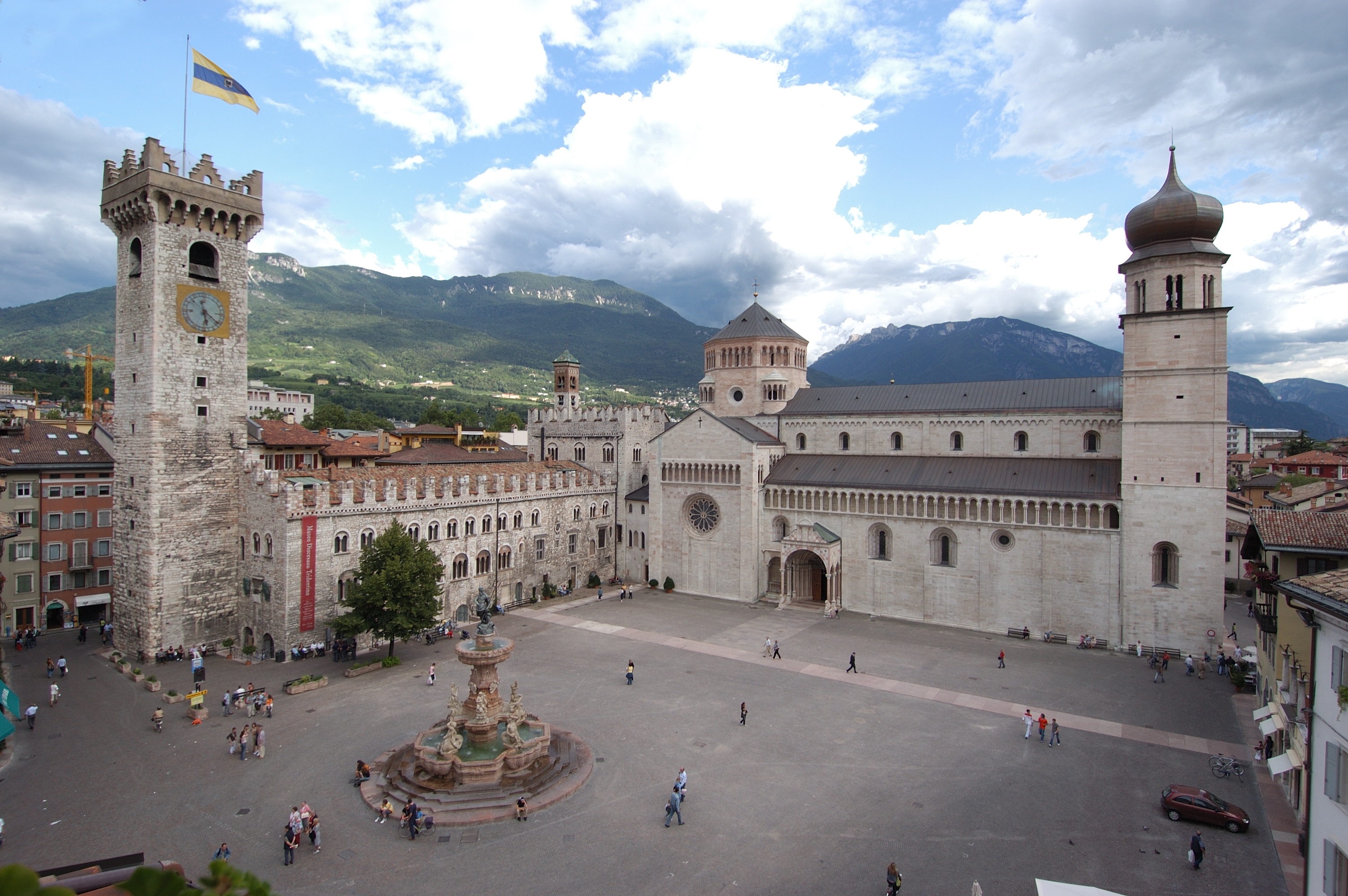|
Faedo, Trentino
Faedo (''Faé'' in local dialect) was a ''comune'' (municipality) in Trentino in the northern Italian region Trentino-Alto Adige/Südtirol, located about north of Trento. Faedo was annexed to the municipality of San Michele all'Adige as of 1 January 2020. As of 31 December 2004, it had a population of 566 and an area of .All demographics and other statistics: Italian statistical institute Istat. Geography Faedo borders the following municipalities: Mezzocorona, Giovo and Salorno Salorno sulla Strada del Vino (; ) is the southernmost ''comune'' (municipality) and a village in South Tyrol in northern Italy, located about southwest of the city of Bolzano. It is one of only five mainly Italian-speaking municipalities in S .... Demographic evolution Colors= id:lightgrey value:gray(0.9) id:darkgrey value:gray(0.8) id:sfondo value:rgb(1,1,1) id:barra value:rgb(0.6,0.7,0.8) ImageSize = width:455 height:303 PlotArea = left:50 bottom:50 top:30 right:30 DateFormat = x. ... [...More Info...] [...Related Items...] OR: [Wikipedia] [Google] [Baidu] |
Trentino-Alto Adige/Südtirol
Trentino-Alto Adige/Südtirol ( ; ; ), often known in English as Trentino-South Tyrol or by its shorter Italian name Trentino-Alto Adige, is an Regions of Italy#Autonomous regions with special statute, autonomous region of Italy, located in the Northern Italy, northern part of the country. The region has a population of 1.1 million, of whom 62% speak Italian language as their mother tongue, 30% speak German language, German and several foreign languages are spoken by immigrant communities. Since the 1970s, most legislative and administrative powers have been transferred to the two self-governing Provinces of Italy, provinces that make up the region: the province of Trento, commonly known as Trentino, and the province of Bolzano, commonly known as South Tyrol (). In South Tyrol, South Tyrol#Languages, German remains the sizeable majority language. From the 9th century until 1801, the region was part of the Holy Roman Empire. After being part of the short-lived Italian Republic (N ... [...More Info...] [...Related Items...] OR: [Wikipedia] [Google] [Baidu] |
Trentino
Trentino (), officially the Autonomous Province of Trento (; ; ), is an Autonomous province#Italy, autonomous province of Italy in the Northern Italy, country's far north. Trentino and South Tyrol constitute the Regions of Italy, region of Trentino-Alto Adige/Südtirol, an autonomous region under the constitution. The province is composed of 166 ''comuni'' (: ''comune''). Its capital is the city of Trento (Trent). The province covers an area of more than , with a total population of 541,098 in 2019. Trentino is renowned for its Mountain, mountains, such as the Dolomites, which are part of the Alps. Etymology The province is generally known as "Trentino". The name derives from Trento, the capital city of the province. Originally, the term was used by the local population only to refer to the city and its immediate surroundings. Under former Austrian Empire, Austrian rule, which began in the 19th century (previously, Trentino was governed by the local bishop), the common German ... [...More Info...] [...Related Items...] OR: [Wikipedia] [Google] [Baidu] |
Communes Of Trentino
The list shows the municipalities (''comune, comuni'') of the autonomous province of Trento, Italy. Trentino is divided into 176 administrative subdivisions (''Comuni/municipalities of South Tyrol, Gemeinden''). Some municipalities have a second official language such as German language, German (Cimbrian language, Cimbrian and Mócheno language, Mócheno) and Ladin language, Ladin. Most German names of municipalities however are historical apart from the previously mentioned communities. The Ladin variety of the Fassa Valley is currently the only officially recognized one, in contrast to the varieties of Val di Non, Non and Sole Valley). List See also * Municipalities of South Tyrol * Prontuario dei nomi locali dell'Alto Adige References {{Trentino Municipalities of Trentino, ... [...More Info...] [...Related Items...] OR: [Wikipedia] [Google] [Baidu] |
Italy
Italy, officially the Italian Republic, is a country in Southern Europe, Southern and Western Europe, Western Europe. It consists of Italian Peninsula, a peninsula that extends into the Mediterranean Sea, with the Alps on its northern land border, as well as List of islands of Italy, nearly 800 islands, notably Sicily and Sardinia. Italy shares land borders with France to the west; Switzerland and Austria to the north; Slovenia to the east; and the two enclaves of Vatican City and San Marino. It is the List of European countries by area, tenth-largest country in Europe by area, covering , and the third-most populous member state of the European Union, with nearly 59 million inhabitants. Italy's capital and List of cities in Italy, largest city is Rome; other major cities include Milan, Naples, Turin, Palermo, Bologna, Florence, Genoa, and Venice. The history of Italy goes back to numerous List of ancient peoples of Italy, Italic peoples—notably including the ancient Romans, ... [...More Info...] [...Related Items...] OR: [Wikipedia] [Google] [Baidu] |
Trento
Trento ( or ; Ladin language, Ladin and ; ; ; ; ; ), also known in English as Trent, is a city on the Adige, Adige River in Trentino-Alto Adige/Südtirol in Italy. It is the capital of the Trentino, autonomous province of Trento. In the 16th century, the city was the location of the Council of Trent. Formerly part of Austrian Empire, Austria and Austria-Hungary, it was annexed by Kingdom of Italy, Italy in 1919. With 118,142 inhabitants, Trento is the third largest city in the Alps and second largest in the historical region of Tyrol. Trento is an educational, scientific, financial and political centre in Trentino-Alto Adige/Südtirol, in Tyrol and Northern Italy in general. The city contains a picturesque Medieval and Renaissance historic centre, with ancient buildings such as Trento Cathedral and the Castello del Buonconsiglio. Together with other Alpine towns Trento engages in the Alpine Town of the Year Association for the implementation of the Alpine Convention to achie ... [...More Info...] [...Related Items...] OR: [Wikipedia] [Google] [Baidu] |
San Michele All'Adige
San Michele all'Adige (Gallo-Italic languages, Trentino dialect: ''Samichél''Teresa Cappello, Carlo Tagliavini, ''Dizionario degli Etnici e dei Toponimi Italiani'', Bologna, ed. Pàtron, 1981.) is a ''Communes of Trentino, comune'' (municipality) in Trentino in the northern Italy, Italian region Trentino-Alto Adige/Südtirol, located about north of Trento. Geography The municipality borders the nearby municipalities of Giovo, Lavis, Mezzocorona, Mezzolombardo, and Nave San Rocco. It includes the two ''frazione, frazioni'' (civil parishes) of Grumo and Faedo, Trentino, Faedo, and is situated on both sides of the Adige River, Adige. Transportation Transportation links include the Brenner_Railway, railway line from Verona to Innsbruck away at nearby Mezzocorona and the Autostrada_A22_(Italy), Autostrada #22 controlled access highway, with a tollbooth located in Grumo. San Michele sits at the intersection of and . A canal ("fossa") originating in Kaltern_an_der_Weinstraße, Kalt ... [...More Info...] [...Related Items...] OR: [Wikipedia] [Google] [Baidu] |
National Institute Of Statistics (Italy)
The Italian National Institute of Statistics (; Istat) is the primary source of official statistics in Italy. The institute conducts a variety of activities, including the census of population, economic censuses, and numerous social, economic, and environmental surveys and analyses. Istat is the largest producer of statistical information in Italy and is actively involved in the European Statistical System, which is overseen by Eurostat. History The Italian National Institute of Statistics () was established by Legislative decree no. 1162 on 9 July, 1926, as the Central Institute of Statistics () in order to replace the General Statistics Division of the Ministry of Agriculture, Food Sovereignty and Forests (Italy), Ministry of Agriculture. Corrado Gini was established as the first director of the institute, under the authority of the head of state. The institute, with a staff of about 170 workers, was charged with publishing the data of the 6th general population census, gener ... [...More Info...] [...Related Items...] OR: [Wikipedia] [Google] [Baidu] |
Mezzocorona
Mezzocorona (; ''Mezacoróna'' in local dialect, ''Kronmétz'' or ''Deutschmétz'' in german language), is a ''Communes of Trentino, comune'' (municipality) in Trentino in the northern Italy, Italian region Trentino-Alto Adige/Südtirol, located about north of the city of Trento and within of the South Tyrol, Südtirol border. Toponymy The name is thought to derive from the Italian language, Italian words ''mezzo'', meaning "middle" or "in-between", and ''corona'', which means "crown" (and is likely a reference to the shape of nearby ''Castel San Gottardo''). Another possible origin is to be found in the dialect of the area: ''mez'' (with the variant ''miz'') which means "wet, soggy". In fact, Mezzocorona was a marshy area until the 19th century, when swamplands were eventually reclaimed and Noce's outlet into Adige River moved further downstream, near Zambana. In 1194 the Counts of Tyrol took control of the area. After this event (the population of the town became predomina ... [...More Info...] [...Related Items...] OR: [Wikipedia] [Google] [Baidu] |
Giovo
Giovo (''Gióf'' in local dialect) is a ''comune'' (municipality) in Trentino, located about northeast of Trento in northern Italy. People The village of Palù di Giovo is home to several professional road bicycle racers: *Francesco Moser - cyclist (now turned local politician). *Gilberto Simoni - cyclist *Moreno Moser Moreno Moser (born 25 December 1990) is an Italian former professional road racing cyclist, who rode professionally between 2012 and 2019 for the , , and the teams. Born in Trento, Moser comes from a family of professional cyclists; his uncles ... - cyclist References Cities and towns in Trentino-Alto Adige/Südtirol {{TrentinoAltoAdige-geo-stub ... [...More Info...] [...Related Items...] OR: [Wikipedia] [Google] [Baidu] |
Salorno
Salorno sulla Strada del Vino (; ) is the southernmost ''comune'' (municipality) and a village in South Tyrol in northern Italy, located about southwest of the city of Bolzano. It is one of only five mainly Italian-speaking municipalities in South Tyrol. Geography The village centre is located on a scree in the Adige (''Etsch'') valley, about northeast of the city of Trento and about southwest of Bolzano. Parts of the municipal area belong to the Trudner Horn Nature Park nature reserve, which is part of the Natura 2000 network. Salorno station is a stop on the Brenner Railway line from Innsbruck to Verona. In the northwest, Salorno borders the South Tyrolean municipalities of Kurtinig, Margreid, Montan, and Neumarkt. In the east and south it borders the Trentino municipalities of Altavalle, Capriana, Cembra Lisignago, Giovo, Grauno, Grumes, Mezzocorona, Roverè della Luna and Valda. The ''Chiusa di Salorno'' (''Salurner Klause''), a narrow section of the Adige ... [...More Info...] [...Related Items...] OR: [Wikipedia] [Google] [Baidu] |
Cities And Towns In Trentino-Alto Adige/Südtirol
A city is a human settlement of a substantial size. The term "city" has different meanings around the world and in some places the settlement can be very small. Even where the term is limited to larger settlements, there is no universally agreed definition of the lower boundary for their size. In a narrower sense, a city can be defined as a permanent and Urban density, densely populated place with administratively defined boundaries whose members work primarily on non-agricultural tasks. Cities generally have extensive systems for housing, transportation, sanitation, Public utilities, utilities, land use, Manufacturing, production of goods, and communication. Their density facilitates interaction between people, government organisations, government organizations, and businesses, sometimes benefiting different parties in the process, such as improving the efficiency of goods and service distribution. Historically, city dwellers have been a small proportion of humanity overall, bu ... [...More Info...] [...Related Items...] OR: [Wikipedia] [Google] [Baidu] |






